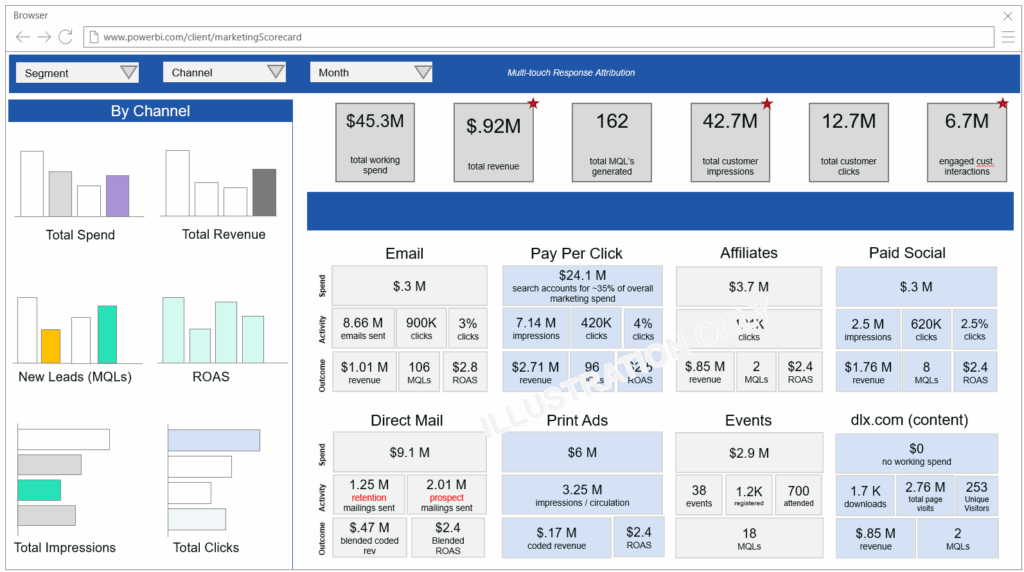Creating a Unified Executive Marketing Scorecard for a leading Financial Services and Payments Technology Company
How Solvenna helped a leading financial services and payments technology company gain a unified, executive-level view of marketing performance through data integration, custom attribution modeling, and a standardized analytics framework.

THE CHALLENGE
Fragmented Marketing Reporting Across Business Units
Our client, a trusted leader in financial technology, data, and payments, faced a common yet complex challenge: each business unit managed marketing analytics independently.
Reporting methods, metrics, and data definitions varied across divisions making it difficult for executives to view overall marketing performance or make confident, organization-wide decisions. Moreover, their business was supported by complex multi-channel marketing that included, but not limited to, direct mail, email, outbound calls, sms texts, webinars, events, social media and programmatic media.
Without a consistent framework, the CMO’s team spent significant time reconciling reports, debating metrics, and manually piecing together insights that often-lacked alignment. This fragmentation hindered visibility into campaign effectiveness, ROI, and enterprise-wide marketing impact.
THE SOLUTION
Build an Executive-Level Scorecard That Tells a Consistent Story
An Iterative, Data-Driven Approach
To transform the client’s fragmented marketing reporting into a cohesive enterprise view, Solvenna used an iterative delivery model, ensuring alignment and adoption at every step.
PHASE 1:
Discovery and Alignment
Mapped current reporting processes across all BUs, documenting differences in data structures, KPIs, and visualization tools. Defined a unified reporting vision tailored for executive stakeholders.
PHASE 2:
Data Wrangling and Integration
Consolidated and standardized data from multiple sources—including CRM, marketing automation, and digital channels into a single, validated data model. Addressed data quality challenges, duplicate logic, and inconsistent field mappings.
PHASE 3:
Custom Attribution Framework
Developed a tailored attribution methodology to link marketing touchpoints to pipeline and revenue contribution. Our approach included a combination of first, last and multi-touch depending on the data set and source. This enabled a more accurate understanding of campaign effectiveness and marketing ROI across the full customer journey.
PHASE 4:
Executive Scorecard Development
Built a Power BI-based Executive Marketing Scorecard with clear hierarchy, intuitive visualizations, and flexible drill-down capabilities. The design highlighted key performance categories – awareness, engagement, pipeline impact, and spend efficiency – within a single, unified view.
THE RESULTS
A Single Source of Truth for Executive Marketing Insights
With the new Executive Marketing Scorecard, our client gained a holistic, consistent, and actionable view of marketing performance for the first time. The executive team’s mindset shifted FROM wondering about the value of marketing without a holistic view of its true activity and outcomes TO modeling where to invest the next set of funds in order to get the greatest return (by channel, product, etc.).
Here is an example of our Executive Marketing Scorecard solution. This can be deployed using PowerBI, Tableau or QuickSight.
Key Outcomes:
- Unified Reporting Framework: Eliminated fragmented dashboards and manual reconciliation efforts across business units.
- Executive Alignment: Created a consistent “one version of truth” for marketing performance discussions.
- Improved Attribution Accuracy: Connected spend and outcomes through a flexible, data-driven attribution model.
- Operational Efficiency: Reduced manual data preparation time and increased focus on insight generation.
- Broader Impact: The same framework is now leveraged for planning, campaign optimization, and performance reviews across the enterprise.
Beyond Reporting: Expanding Value Across the Organization
The Executive Marketing Scorecard has become more than just a reporting tool—it’s now a strategic enabler that drives collaboration across teams.
Additional benefits include:
- Performance benchmarking across BUs to identify high-performing campaigns and best practices.
- Enhanced forecasting and planning through consistent historical trend visibility.
- Integration with financial and sales reporting to link marketing investment directly to business growth.

WE CAN HELP
At Solvenna, we help organizations bridge the gap between marketing and analytics by turning complex, siloed data into clear, actionable insights. Our team brings a blend of business acumen, data engineering expertise, and storytelling skill to build solutions that drive adoption and results.


